Fostair® pMDI
Your doctor, nurse or pharmacist has prescribed Fostair pMDI to help you to manage your asthma (100/6 and 200/6) or COPD (100/6 only).
‘pMDI’ stands for ‘pressurised metered dose inhaler’, and your prescribed inhaler should look like one of the inhalers shown here.
Taking your inhaler as prescribed can help to manage your symptoms, and this page contains information to help you with this.
Remember, should you need additional advice regarding your asthma or COPD, please speak to your doctor, nurse or pharmacist.
For resources for your condition, please click the relevant button in line with your prescription.
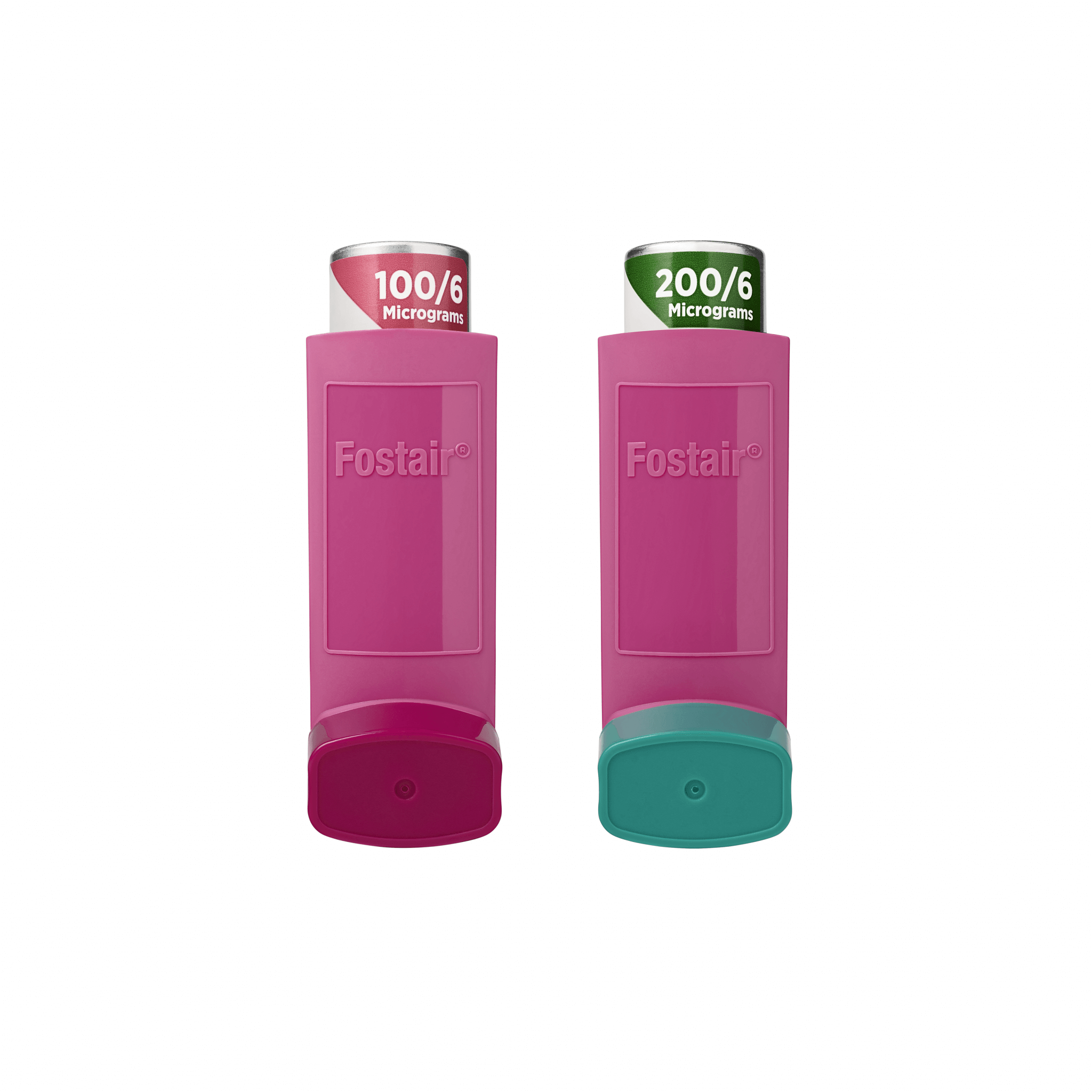
Fostair pMDI Patient Information Leaflets
Asthma & COPD
Fostair (GB) 100/6Asthma
Fostair (GB) 200/6
How to use your Fostair pMDI
Firstly, it’s important to read all of the Patient Information Leaflet provided with your inhaler carefully before you start using this medicine because it contains important information for you.
You can download the Patient Information Leaflet for Fostair 100/6 or Fostair 200/6 on these links.
Your doctor, nurse or pharmacist will advise you on how Fostair should be taken in combination with any other medication and provide you with an action plan to help you manage your respiratory symptoms.

First use
Before using the inhaler for the first time or if you have not used the inhaler for 14 days or more, you should test your inhaler to make sure that it is working properly.
- Remove the protective cap from the mouthpiece
- Hold your inhaler upright with the mouthpiece at the bottom
- Direct the mouthpiece away from yourself and firmly depress the canister to release 1 puff
- Check the dose counter. If you are testing your inhaler for the first time, the counter should read 120.
Everyday use
To use your Fostair inhaler, follow the 5 steps shown here. Don’t rush yourself, especially during steps 2 to 5.
-
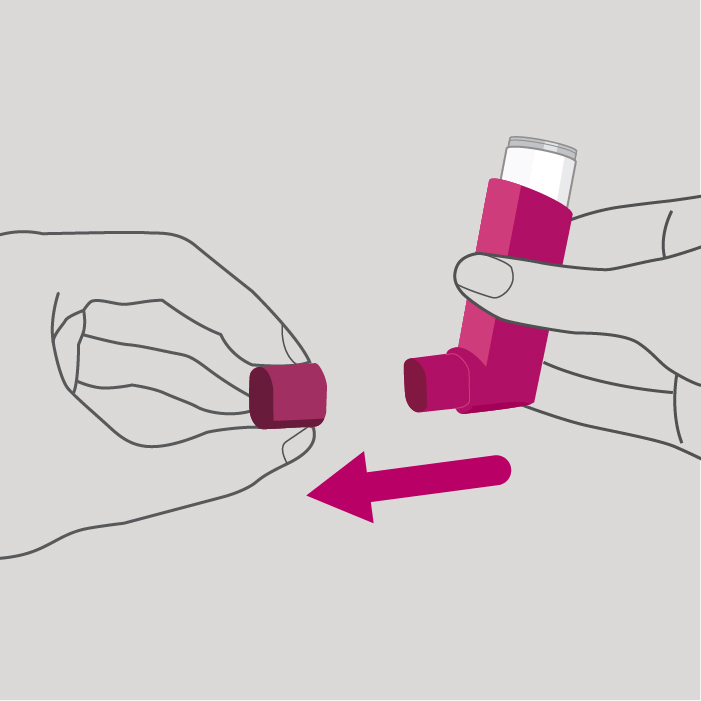
Step 1
Whenever possible, sit or stand in an upright position when using your inhaler.
Remove the protective cap from the mouthpiece and check that the mouthpiece is clean and free from dust, dirt or any foreign objects.
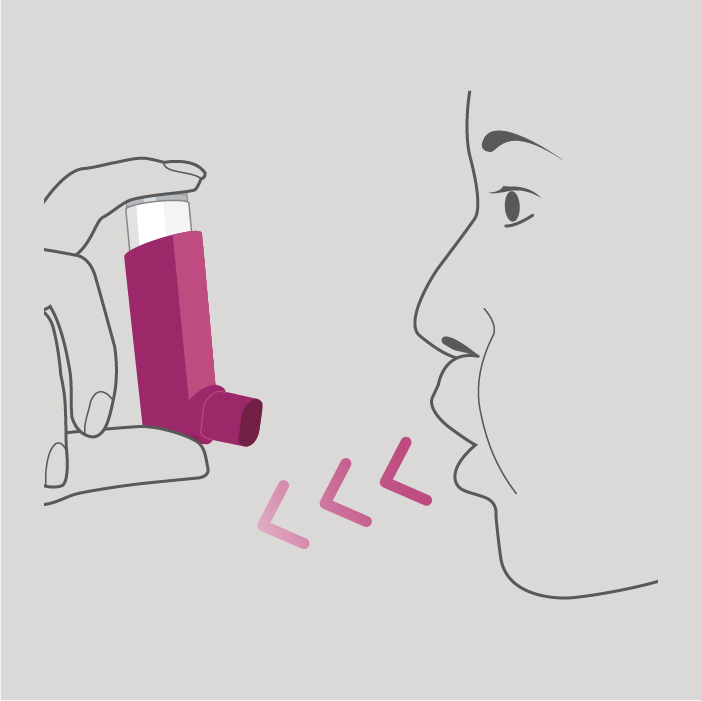
Step 2
Breathe out as slowly and deeply as possible.
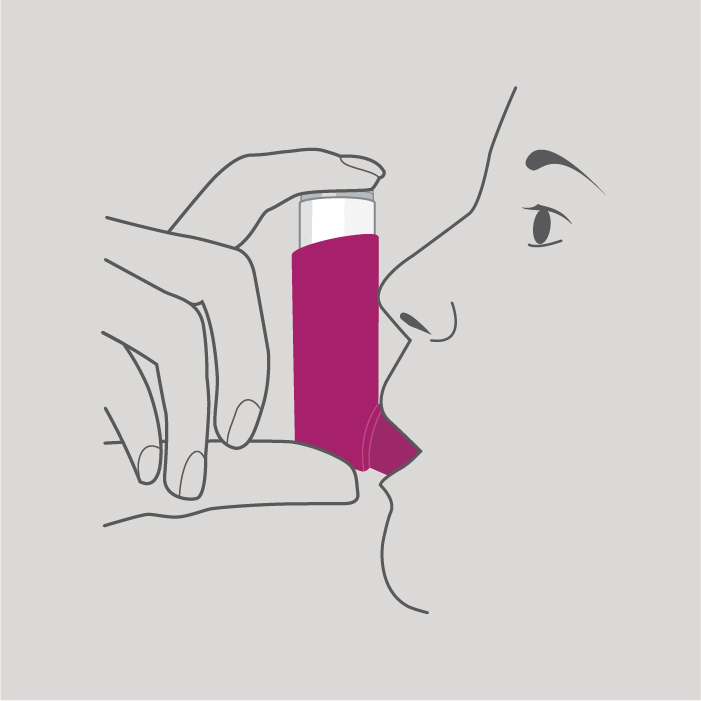
Step 3
Hold the inhaler upright as shown and put your lips around the mouthpiece.
Do not bite the mouthpiece.
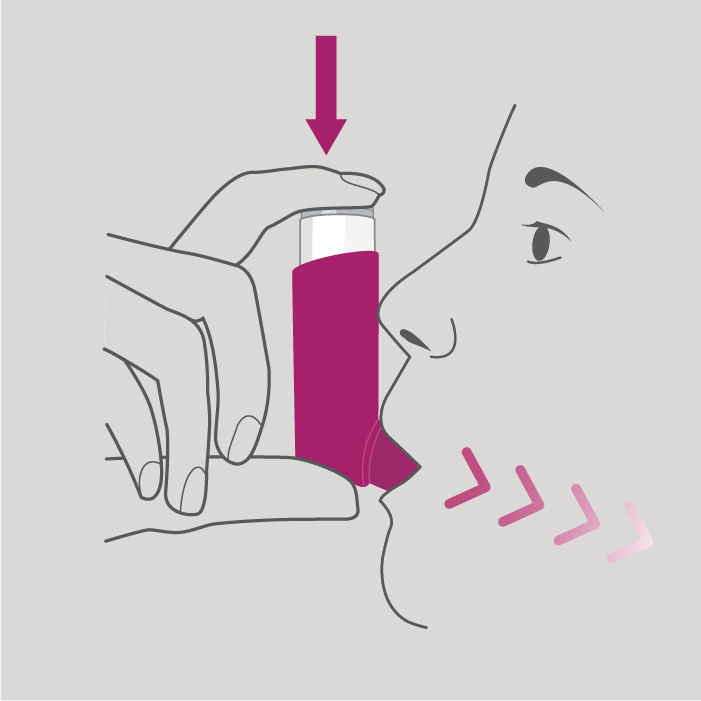
Step 4
Breathe in slowly and deeply through your mouth and, just after starting to breathe in, press down on the top of the inhaler to release 1 puff whilst continuing to breathe in slowly and deeply.

Step 5
Hold your breath for as long as is comfortable and, finally, remove the inhaler from your mouth and breathe out slowly.
Do not breathe out into the inhaler.
To take a second dose
Keep your inhaler in the upright position for about half a minute, then repeat steps 2 to 5.
Take your time.
IMPORTANT: Do not repeat steps 2 to 5 too quickly.
See the information below about what to do after you have used your inhaler.
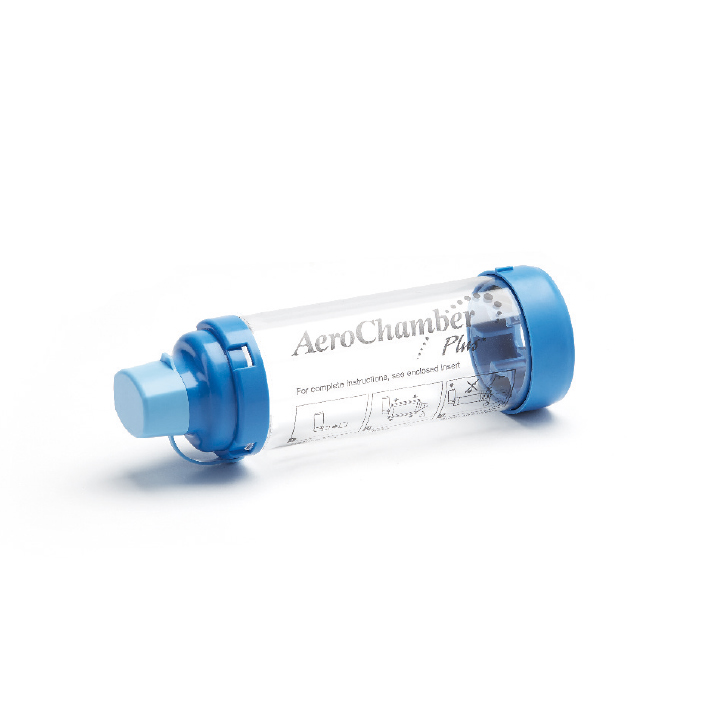
Using a spacer
Your doctor, nurse or pharmacist may have prescribed you a spacer, called an AeroChamber Plus® to use with your inhaler.
Your spacer may look like a long chamber with a mouthpiece at one end and a hole at the other where it attaches to your inhaler.
Follow the next 7 steps to use your Fostair inhaler with a spacer. Don’t forget to refer to the information leaflet that comes with the AeroChamber Plus® spacer, or speak to your doctor, nurse or pharmacist for more information or help.
How to use Fostair with a spacer
Follow the next 7 steps to use your inhaler with a spacer. Don’t forget to refer to the information leaflet that comes with the AeroChamber Plus® spacer, or speak to your doctor, nurse or pharmacist for more information or help.
-

Step 1
Remove the protective cap from your inhaler and the spacer mouthpiece.
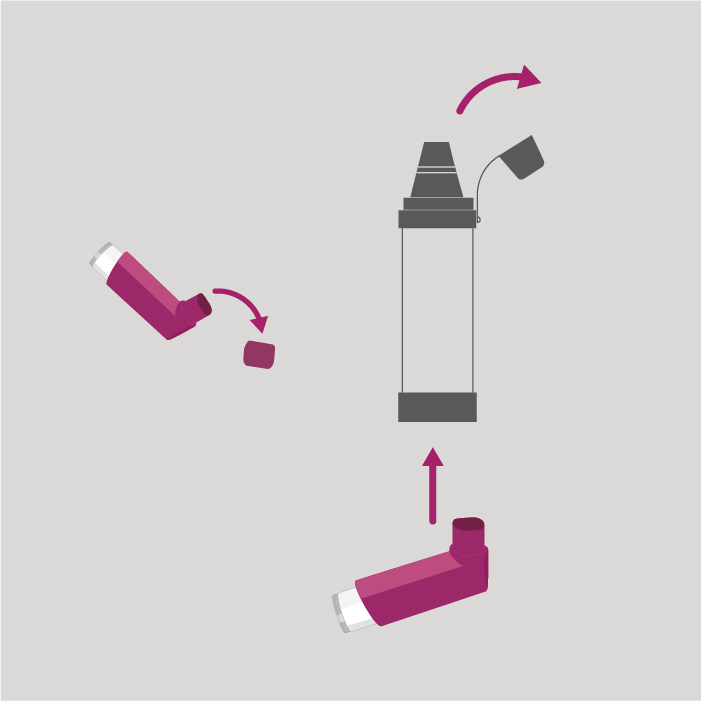
Step 2
Make sure the spacer is clear and there are no objects that could block the flow of air.
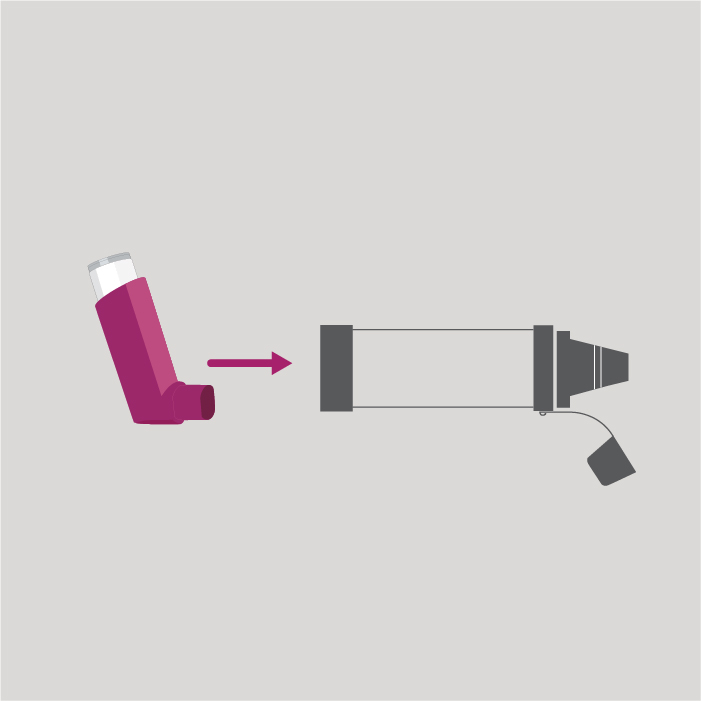
Step 3
Insert your inhaler into the hole in the back of the spacer.
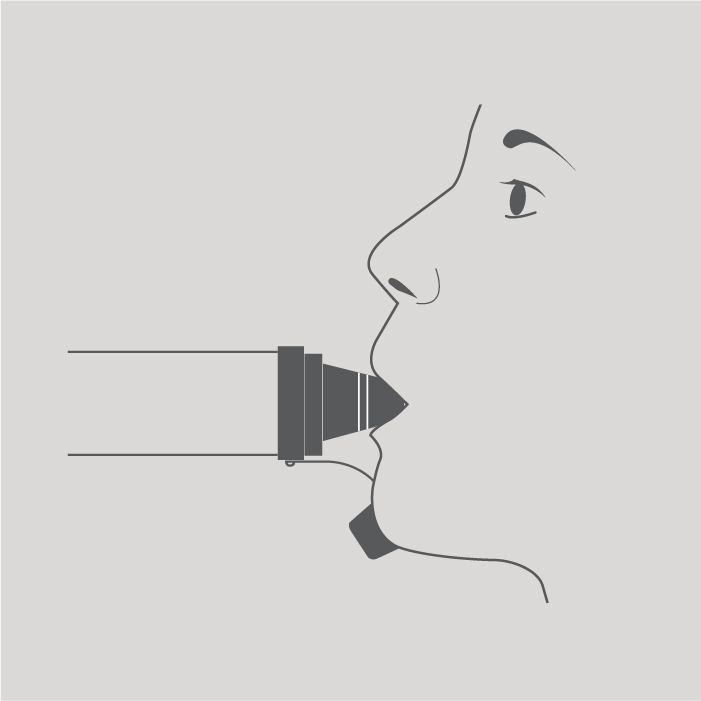
Step 4
Put the spacer mouthpiece into your mouth.
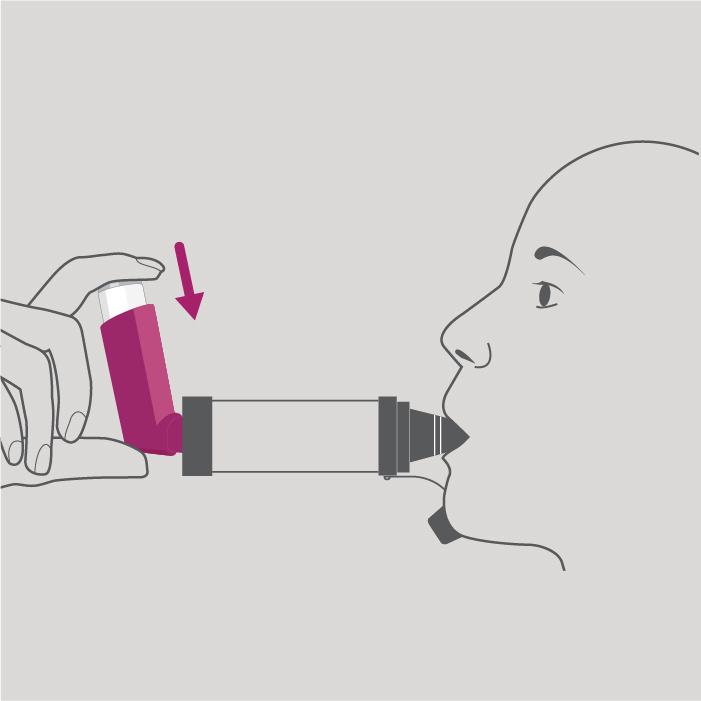
Step 5
Push down on the top of the inhaler and start breathing in slowly. Keep a good seal around the spacer mouthpiece and take 5 breaths after pushing down on the top of the inhaler.

Step 6
Slow down your breathing if you hear a whistle sound.

Step 7
Wait 30 seconds before repeating steps 4-6 as prescribed.
After use
After use, replace the protective cap and check the dose counter.
The dose counter should decrease by 1 with every puff.
To lower the risk of a fungal infection in your mouth and throat, rinse your mouth or gargle with water, without swallowing, or brush your teeth each time after you use your inhaler.
Make sure you clean your Fostair inhaler every week as described in the patient information leaflet within the pack.
Replacements and disposal
You should get a replacement inhaler when the dose counter shows the number ‘20’. Stop using the inhaler when the dose counter shows ‘0’. This is because any medicine left in the inhaler may not be enough to give you a full dose.
Medicines should not be disposed of via waste water or household waste. Ask your pharmacist how to dispose of medicines no longer required. These measures will help to protect the environment.
In line with your prescription, select the Fostair for asthma (100/6 and 200/6) or Fostair for COPD (100/6 only) tab for specific resources for your condition.

Fostair pMDI for asthma
Your inhaler contains two medications:
- Beclometasone, a corticosteroid, that helps to reduce swelling and inflammation in your lungs
- Formoterol, a long-acting bronchodilator, that helps to open up the airways to help make breathing easier.
lt is important that you know how to use your inhaler properly.
Your doctor, nurse or pharmacist will show you how to use your inhaler correctly. You should follow their instructions carefully so that you know how many puffs to inhale, and when. It is important that you use your preventer inhaler as prescribed, even if you feel well, as this will help control your asthma symptoms.
Fostair pMDI 100/6 for maintenance and reliever therapy (MART)
You may have been prescribed Fostair pMDI 100/6 for maintenance and reliver therapy (MART). Always use this medicine exactly as your doctor, nurse or pharmacist has told you.
You may previously have used a blue inhaler as a reliever inhaler, but with MART, your Fostair pMDI 100/6 inhaler can now do the job of both your usual maintenance therapy and your blue reliever inhaler.

Fostair pMDI for COPD
Your inhaler contains two medications:
- Beclometasone, a corticosteroid, that helps to reduce swelling and inflammation in your lungs
- Formoterol, a long-acting bronchodilator, that helps to open up the airways to help make breathing easier.
lt is important that you know how to use your inhaler properly.
Take your inhaler 2 puffs in the morning, 2 puffs in the evening.
Your doctor, nurse or pharmacist will show you how to use your inhaler correctly. It is important that you use your preventer inhaler as prescribed, even if you feel well, as this will help control your asthma symptoms.
Your doctor, nurse or pharmacist will advise you on how your Fostair pMDI should be taken in combination with other medication and provide you with an action plan to help you manage your respiratory symptoms.
How to use Fostair pMDI
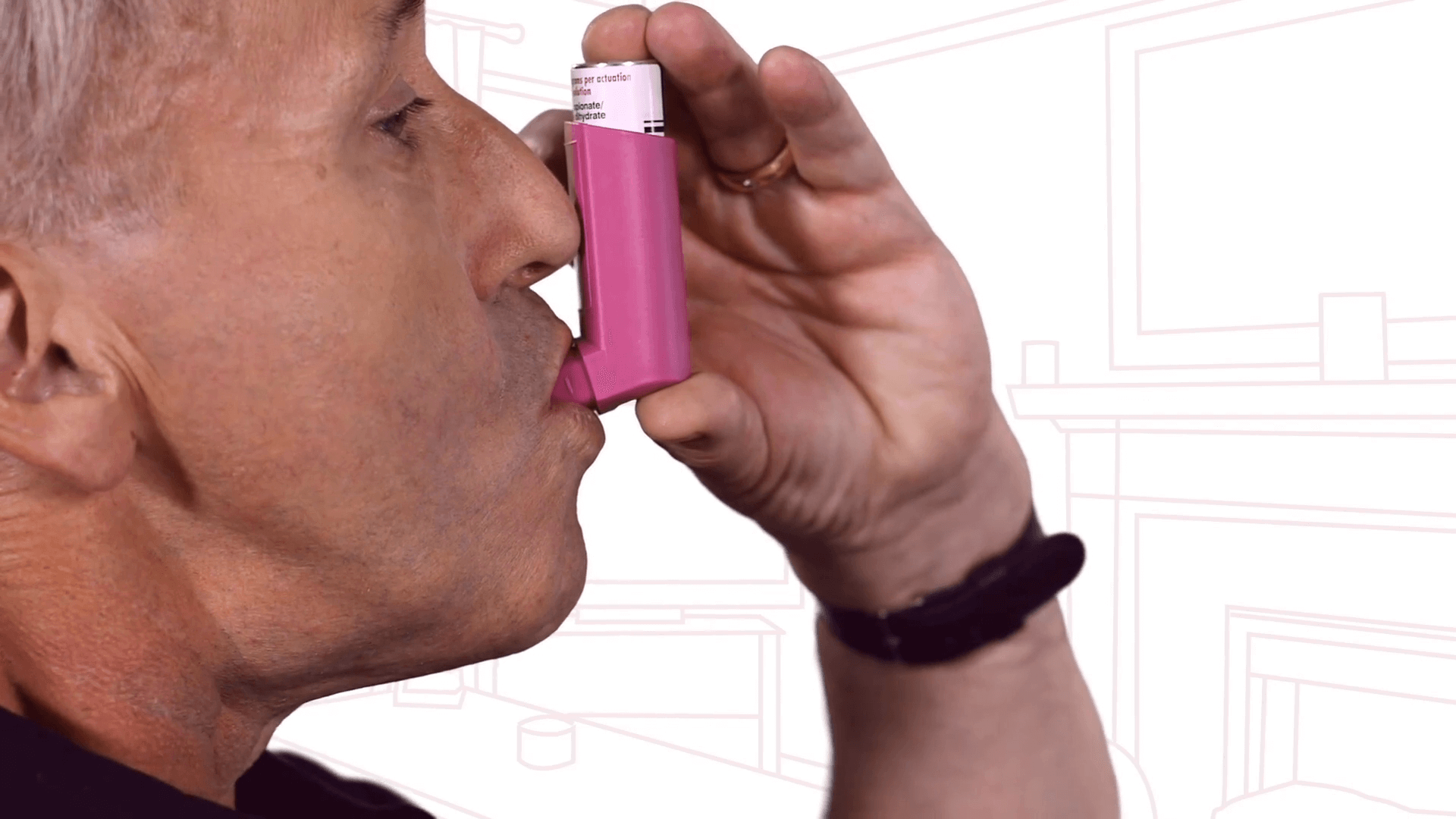
Frequently Asked Questions
Using your inhaler
-
It is very important for you to use this medicine regularly even though you may have no symptoms. Always use this medicine exactly as your doctor, nurse or pharmacist has told you. Check with your doctor, nurse or pharmacist if you are not sure.
Your doctor, nurse or pharmacist will advise you on how this medicine should be taken in combination with any other medication and provide you with an action plan to help you manage your respiratory symptoms.
-
Understandably, when you don’t have any symptoms, it can be easy to forget to take your treatment or to feel like you do not need to.
You must use your inhaler every day, even when you are feeling well. Regular use of your inhaler is the most effective way to keep you feeling this way.
-
Spacers are empty tubes that are usually made from plastic. They slot onto the mouthpiece of your inhaler on one end, and you use a mouthpiece or mask on the spacer at the other end. They help you get the best from your asthma medicine.1
Your doctor, nurse or pharmacist may have prescribed a spacer, called the AeroChamber Plus® to be used with your inhaler. Your spacer may look like a long chamber with a mouthpiece at one end and a hole at the other where it attaches to your inhaler. See step-by-step instructions on how to use your inhaler with a spacer.
It is important that you read the package leaflet which is supplied with your AeroChamber Plus® spacer device, and that you follow the instructions on how to use and how to clean it, carefully.
Looking after your inhaler
-
We advise that you store your inhaler as per the storage recommendations on the outer packaging and in the accompanying Patient Information Leaflet. If you have any questions, talk to your doctor, nurse or pharmacist.
You can download the Patient Information Leaflet for Fostair 100/6 or Fostair 200/6 on these links.
Your Fostair inhaler may be stored at room temperature (not above 25°C) for a maximum of 3 months. Do not use your Fostair inhaler after the expiry date on the label / packaging. Do not pierce the pressurised container.
-
You should clean your inhaler once a week. When cleaning, do not remove the canister from the actuator (the surrounding plastic case) and do not use water or other liquids to clean your inhaler.
To clean your inhaler:
- Remove the protective cap from the mouthpiece by pulling it away from your inhaler
- Wipe inside and outside of the mouthpiece and the actuator with a clean, dry cloth or tissue
- Replace the mouthpiece cover.
Instructions on how to clean your inhaler are also found in the Patient Information Leaflet included in the device packaging. You can download the Patient Information Leaflet for Fostair 100/6 or Fostair 200/6 on these links.
-
How long your inhaler lasts can depend on several factors, including the dose you’re prescribed. You should order a replacement when the dose counter shows ‘20’. You should not use your inhaler once the dose counter approaches zero.
Side effects and other medications
-
Like all medicines, Fostair may cause side effects, although not everybody gets them. If you do get any side effects, talk to your doctor, pharmacist or nurse. This includes any possible side effects not listed in the Patient Information Leaflet. You can download the Patient Information Leaflet for Fostair 100/6 or Fostair 200/6 on these links.
You can also report side effects directly via the Yellow Card Scheme. By reporting side effects you help provide more information on the safety of this medicine.
-
Your doctor, nurse or pharmacist can advise you about using other prescribed medications. You should also check with your pharmacist before taking medicines bought over the counter.
You must tell your doctor, nurse or pharmacist about any medication you may be taking, including herbal remedies.
It can be isolating, suffering from a condition that may limit your ability to get out and about. There is a lot of information available online, but it’s important to go to a reliable source. The suggested resources listed below can offer you further support on the various aspects of living with COPD or asthma.
NHS
Helpline: 111 (non-emergency)
NHS asthma information
NHS COPD information
NHS Smokefree
Asthma + Lung UK
Helpline: 0300 222 5800 (non-emergency)
Explore support for asthma
Explore support for COPD
Reference
-
- Asthma + Lung UK. Spacers. Available at: https://www.asthma.org.uk/symptoms-tests-treatments/treatments/spacers
The information provided here is not intended to replace the advice of your healthcare professional. If you have any questions about your medication, please speak to your doctor, nurse or pharmacist.
AreoChamber Plus® is a registered trademark of Trudell Medical International.
If you have not been prescribed Fostair and are looking for information on another Chiesi respiratory product please visit our homepage.
Reporting of side effects: If you get any side effects, talk to your doctor, pharmacist or nurse. This includes any possible side effects not listed in the package leaflet. You can also report side effects directly via the Yellow Card Scheme at: https://yellowcard.mhra.gov.uk. By reporting side effects you can help provide more information on the safety of this medicine.

